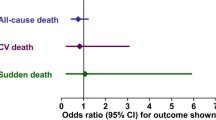Summary
In vitro experiments on rings from coronary arteries, femoral arteries, and femoral veins of sheep were performed, and cumulative concentration-relaxation responses were established for glyceryl trinitrate (GTN) and the molsidomine metabolite SIN-1. Paired preparations of control and deendothelialized coronary artery rings were used, and the vessels were precontracted with different agonists at a concentration that elicited 30% of maximal contractions (EC-30). In coronary arteries, the responses for GTN and SIN-1 on normal and deendothelialized preparations were not significantly different. In coronary arteries preincubated with 0.44 mM GTN or SIN-1 to study tolerance development, there was a significant loss of efficacy to the relaxant effect of GTN, whereas the effect SIN-1 was essentially maintained. Femoral arteries and veins were readily relaxed with GTN and SIN-1. In veins relaxation in relation to resting tone was much more pronounced than in coronary or femoral arteries. In conclusion, the molsidomine metabolite SIN-1 is a potent coronary and venous vasodilator that does not induce tolerance.
Similar content being viewed by others
References
Rapoport RM, Murad F. Endothelial-dependent and nitrovasodilator-induced relaxation of vascular smooth muscle: Role of cyclic GMP.J Cycl Nucl Prot Phos Res 1983:9: 281–291.
Noack E, Feelisch M. Molecular aspects underlying the vasodilator action of molsidomine.J Cardiovasc Pharmacol 1989;14(Suppl. 11):S1-S5.
Flaherty JT. Nitrate tolerance.Drugs 1989;37:527–550.
Bohn H, Schönafinger K. Oxygen and oxidation promote the release of nitric oxide from sydnonimines.J Cardiovasc Pharmacol 1989;14(Suppl. 11):S6-S12.
Bassenge E, Kukovetz WR. Molsidomine. In: Scriabine A, ed.New drugs annual. Cardiovascular drugs. Vol 2. New York: Raven Press, 1984:177–191.
Thulesius O. Cardiovascular pharmacology of molsidomine.Bibl Cardiol 1984;38:234–243.
Thulesius O, Ugaily-Thulesius L, Neglen P, Shuhaiber H. The role of endothelium in the control of venous tone: Studies on isolated human veins.Clin Physiol 1988;8:359–366.
Thulesius O, Stephen FX. Computer assisted drug analysis of dose response curves with special reference to molsidomine.Gen Pharmac 1983;14:91–93.
Ljusegren ME, Ahlner J, Axelsson KL. Studies on vascular smooth muscle tolerance to different cGMP-mediated vasodilators and cross-tolerance to glyceryl trinitrate.Pharmacol Toxicol 1988;62:302–307.
Shirasaki Y, Su C. Endothelium-removal augments vasodilatation by sodium nitroprusside and sodium nitrate.Eur J Pharmacol 1985;114:93–96.
Rafflenbeul W, Bassenge E, Lichtlen PR. Competition between endotheliumand nitroglycerin-induced coronary vasodilatation (abstract).Circulation 1988;78(Suppl. II):II455.
Pohl U, Holtz J, Busse R, Bassenge E. Crucial role of endothelium in the vasodilator response to increased flow in-vivo.Hypertension 1986;8:37–44.
Ahlner J, Axelsson KL. Nitrates mode of action at a cellular level.Drugs 1987;33(Suppl. 4):32–38.
Keith RA Burkmann AM, Sokoloski TD, Fertel RH. Vascular tolerance to nitroglycerin and cyclic GMP generation in rat aortic smooth muscle.J Pharmacol Exp Ther 1983;221: 525–531.
Kukovetz WR, Holzmann S. Mechanism of nitrate-induced vasodilatation and tolerance.Z Kardiol 1983;72(Suppl. 3):14–19.
Kukovetz WR, Holzmann S, Romanin C. Cyclic GMP and tolerance to nitrates. In: Vanhoutte PM, ed.Vasodilatation: vascular smooth muscle, peptides, autonomic nerves and endothelium. New York: Raven Press, 1988:49–54.
Axelsson KL, Andersson RGG, Wikberg JES. Vascular smooth muscle relaxation by nitrocompounds: Reduced relaxation and cGMP elevation in tolerant vessels and reversal of tolerance by dithiothreitol.Acta Pharmacol Toxicol 1982;50:350–357.
Author information
Authors and Affiliations
Rights and permissions
About this article
Cite this article
Mariam, H., Yousif, F. & Thulesius, O. Effect of the molsidomine metabolite SIN-1 on coronary arteries and peripheral vessels of sheep with special reference to tolerance and endothelium. Cardiovasc Drug Ther 5, 769–773 (1991). https://doi.org/10.1007/BF03029753
Issue Date:
DOI: https://doi.org/10.1007/BF03029753




